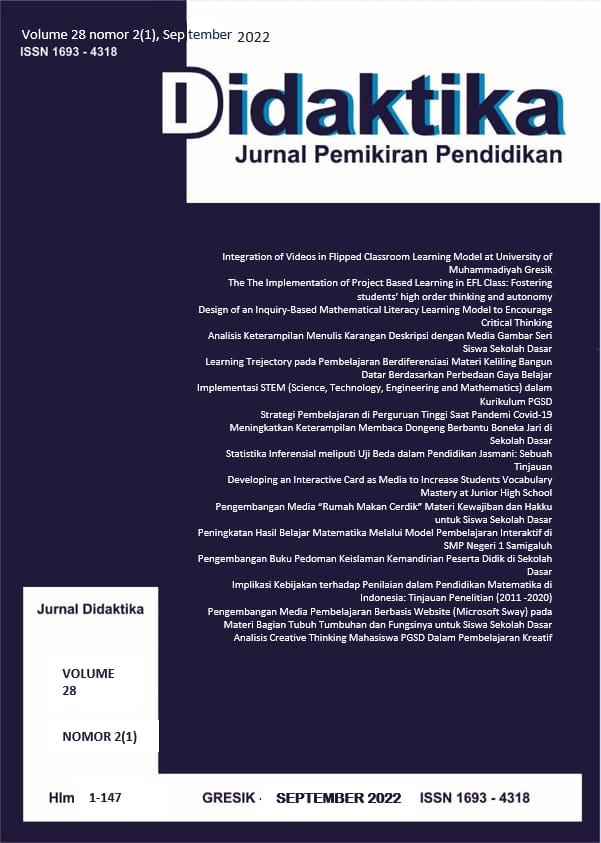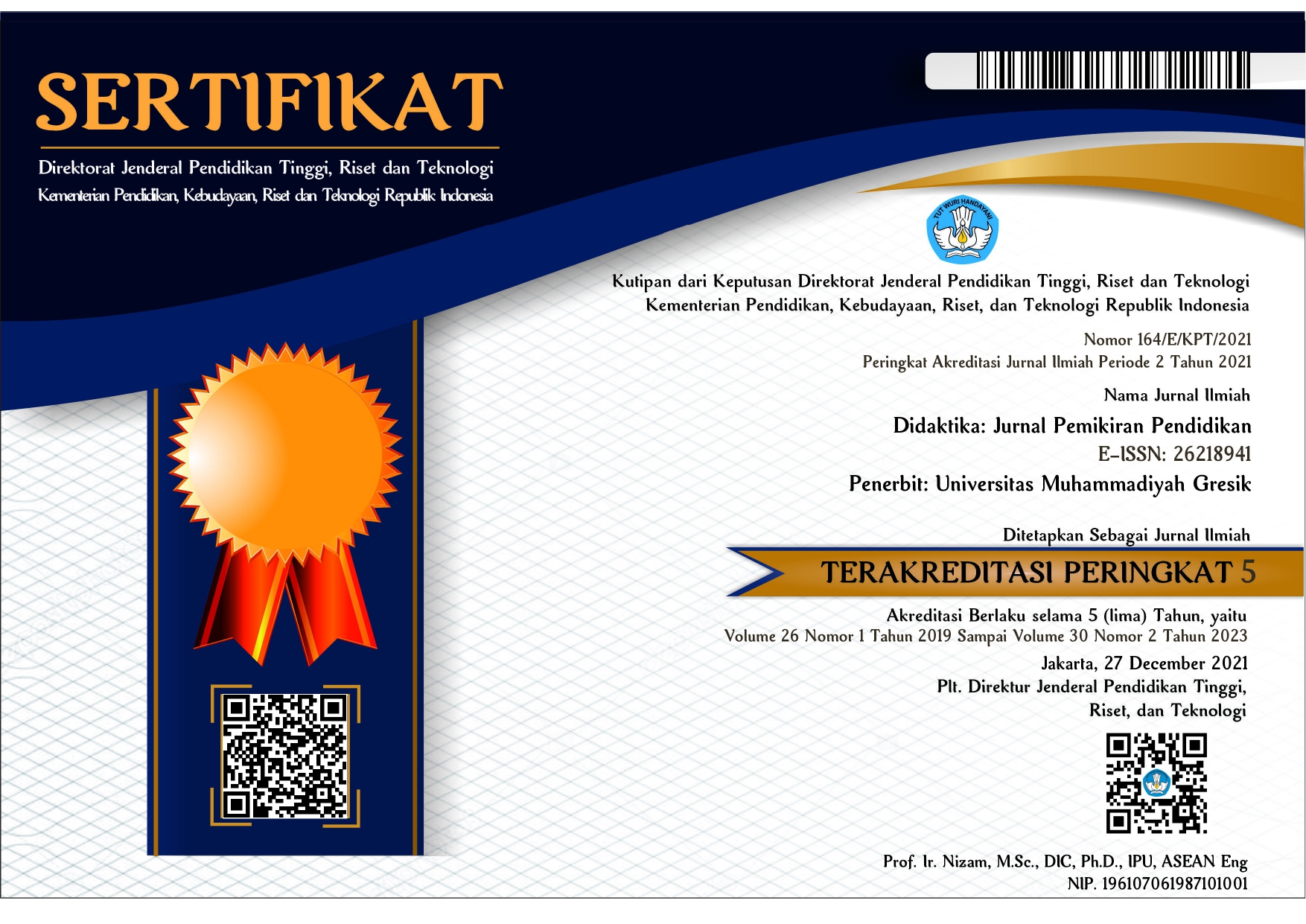Pengembangan Buku Pedoman Keislaman Kemandirian Peserta Didik di Sekolah Dasar
DOI:
https://doi.org/10.30587/didaktika.v28i2.4325Keywords:
Hizbul Wathan; kemandirianAbstract
Tujuan penelitian ini adalah untuk mengembangkan buku saku Hizbul Wathan untuk pengembangan kemandirian peserta didik di Sekolah Dasar Muhammadiyah. Jenis penelitiannya adalah penelitian pengembangan, dengan model 4D yang dikembangkan oleh Thiagarajan. Pada penelitian ini ada 4 tahap penelitian, yaitu define (pendefinisian), design (perencanaan), develop (pengembangan), disseminate (penyebaran). Oleh karena keterbatasan anggaran pada penelitian ini hanya sampai tahap develop (pengembangan), tidak sampai pada tahap disseminate (penyebaran). Buku saku ini telah divalidasi oleh 4 orang validator dari dari sudut kepakaran yang berbeda dan hasilnya layak digunakan sebagai buku panduan dalam pembelajaran kepanduan Hizbul wathan.
References
Aisyah, N., Akib, I., & Syamsuddin, A. (2020). Identifying The Influence Of Anxiety And Self- Reliance In Learning Towards Mathematics Learning Performance Of Elementary School’s Students Grade V. International Journal of Scientific & Technology Research, 9(2), 3238–3242.
Budiman, N. (2006). Memahami Perkembangan Anak Usia Sekolah Dasar. Departemen Pendidikan Nasional.
Dani, A. S., & Anwari, B. (2015). Buku Panduan Pramuka Siaga. Andi.
Dewantara, K. H. (1977). Bagian pertama pendidikan. Percetakan Taman Siswa.
Erikson, E. H. (1994). Identity and the life cycle. WW Norton & Company.
Fahyuni, E. F., & Arifin, M. B. U. B. (2021). Child-Friendly Through Hizbul Wathan in Indonesia Muhammadiyah School. Proceedings of the 1st Paris Van Java International Seminar on Health, Economics, Social Science and Humanities (PVJ-ISHESSH 2020), 535, 132–139. https://doi.org/10.2991/assehr.k.210304.030
Fahyuni, E. F., Sekolah, P., Melalui, R. A., Kepanduan, G., Wathan, H., Membentuk, U., Kepemimpinan, K., Sd, S., Fauji, I., & Addaa’, N. (2020). Application of Child Friendly Schools Through the Hizbul Wathan Scouting Movement To Form Elementary Student Leadership Character. Halaqa: Islamic Education Journal, 4(1), 1–9. https://doi.org/10.21070/halaqa.v4i1.171
Harun, M. (2012). Implementasi Kebijakan Kebangkitan Gerakan Kepanduan Hizbul Wathan Di Kabupaten Gresik. University of Muhammadiyah Malang.
Hermawati, D., Rohaeni, A., & Nurhayati, S. (2021). Implementation Of The Student-Led Conference Method To Develop Children ’ S Self-Reliance. Empowerment : Jurnal Ilmiah Program Studi Pendidikan Luar Sekolah, 10(2252), 73–79.
Sistem pendidikan nasional, (2003).
Karo-Karo, I. R., & Rohani, R. (2018). Manfaat Media Dalam Pembelajaran. AXIOM : Jurnal Pendidikan Dan Matematika, 7(1). https://doi.org/10.30821/axiom.v7i1.1778
Kurniawan, S. (2013). Pendidikan Karakter: Konsepsi & Implementasinya secara Terpadu di Lingkungan Keluarga, Sekolah, Perguruan Tinggi, dan Masyarakat. Ar-Ruzz Media.
Masturi, S. (2016). Menjadi Orang Tua Bijak, 101 Cara Membina Kemandirian dan Tanggung Jawab Anak. Elex Media Komputindo.
Megawangi, R. (2004). Pendidikan karakter solusi yang tepat untuk membangun bangsa. Indonesia Heritage Foundation.
Numri, M. (2015). Meningkatkan Kemandirian Belajar Melalui Layanan Penguasaan Konten Dengan Teknik Latihan Saya Bertanggungjawab. Jurnal Penelitian Tindakan Bimbingan & Konseling, 1(1), 48–53.
Rahayu, Y. S., Sarmini, & Martadi. (2020). Implementation of Character Education at Elementary School Level in Sulawesi, Indonesia. Proceedings of the Tarumanagara International Conference on the Applications of Social Sciences and Humanities (TICASH 2019), 447–457. https://doi.org/10.2991/assehr.k.200515.077
Ratminingsih, N. M., Marhaeni, A. A. I. N., & Vigayanti, L. P. D. (2018). Self-Assessment: The effect on students’ independence and writing competence. International Journal of Instruction, 11(3), 277–290. https://doi.org/10.12973/iji.2018.11320a
Rosyada, A., & AR, E. D. (2018). Fostering the Attitude of Nationalism Through Hizbul Wathan as the Extracurricular to Build Students Character. Proceedings of the Annual Civic Education Conference (ACEC 2018), 423–425. https://doi.org/10.2991/acec-18.2018.97
Sa’diyah, R. (2017). Pentingnya Melatih Kemandirian Anak. Kordinat: Jurnal Komunikasi Antar Perguruan Tinggi Agama Islam, 16(1), 31–46. https://doi.org/10.15408/kordinat.v16i1.6453
Sumantri, M. S., & Rachmadtullah, R. (2016). The effect of learning media and self regulation to elementary students’ history learning outcome. Advanced Science Letters, 22(12), 4104–4108. https://doi.org/10.1166/asl.2016.8140
Tresnaningsih, F., Santi, D. P. D., & Suminarsih, E. (2019). Kemandirian Belajar Siswa Kelas III SDN Karang Jalak I Dalam Pembelajaran Tematik. Pedagogi: Jurnal Penelitian Pendidikan, 6(2). https://doi.org/10.25134/pedagogi.v6i2.2407
Winarto, Khiyarusoleh, U., Ardiyansyah, A., Wilujeng, I., & Sukardiyono. (2018). Pocket book based on comic to improve conceptual understanding of Child Sex Abuse (CSA): A case study of elementary school. International Journal of Instruction, 11(4), 889–900. https://doi.org/10.12973/iji.2018.11456a
Downloads
Published
How to Cite
Issue
Section
License
License and Copyright Agreement
In submitting the manuscript to the journal, the authors certify that:
- They are authorized by their co-authors to enter into these arrangements.
- The work described has not been formally published before, except in the form of an abstract or as part of a published lecture, review, thesis, or overlay journal.
- That it is not under consideration for publication elsewhere,
- That its publication has been approved by all the author(s) and by the responsible authorities – tacitly or explicitly – of the institutes where the work has been carried out.
- They secure the right to reproduce any material that has already been published or copyrighted elsewhere.
- They agree to the following license and copyright agreement.
Copyright
Authors who publish with DIDAKTIKA: Jurnal Pemikiran Pendidikan agree to the following terms:
- Authors retain copyright and grant the journal right of first publication with the work simultaneously licensed under a Creative Commons Attribution License (CC BY-SA 4.0) that allows others to share the work with an acknowledgment of the work's authorship and initial publication in this journal.
- Authors are able to enter into separate, additional contractual arrangements for the non-exclusive distribution of the journal's published version of the work (e.g., post it to an institutional repository or publish it in a book), with an acknowledgment of its initial publication in this journal.
- Authors are permitted and encouraged to post their work online (e.g., in institutional repositories or on their website) prior to and during the submission process, as it can lead to productive exchanges, as well as earlier and greater citation of published work.
Licensing for Data Publication
Open Data and Software Publishing and Sharing
The journal strives to maximize the replicability of the research published in it. Authors are thus required to share all data, code or protocols underlying the research reported in their articles. Exceptions are permitted but have to be justified in a written public statement accompanying the article.
Datasets and software should be deposited and permanently archived inappropriate, trusted, general, or domain-specific repositories (please consult http://service.re3data.org and/or software repositories such as GitHub, GitLab, Bioinformatics.org, or equivalent). The associated persistent identifiers (e.g. DOI, or others) of the dataset(s) must be included in the data or software resources section of the article. Reference(s) to datasets and software should also be included in the reference list of the article with DOIs (where available). Where no domain-specific data repository exists, authors should deposit their datasets in a general repository such as ZENODO, Dryad, Dataverse, or others.
Small data may also be published as data files or packages supplementary to a research article, however, the authors should prefer in all cases a deposition in data repositories.











